#CoffeeAndKlon is my (irregular!) Sunday morning magazine series, where I talk about whatever’s on my mind right now. There’s always coffee, and there’s normally chat about the Klon and its many competitors.

Today, I want to talk klones, and specifically the most important klone pedal ever released: Electro-Harmonix’s Soul Food. Make yourself your favourite morning drink first. This one is going to be a #longread … with audio demos.
Table of Contents
- Lost In The Coffee Forest
- Before Klones Were Everywhere
- An Historically Important Pedal
- What Did You Buy?
- What’s Your Signal Chain Today?
- Can You Use The EHX Soul Food As A Clean Boost?
- We’re Not Done Yet!
- As A Standalone Overdrive Pedal
- Final Thoughts
Lost In The Coffee Forest
As I’m writing this, I’m drinking a cup of Yayu Forest coffee from Union Coffee.
Union Coffee has been a favourite of ours for quite a few years now. When the lockdowns began, a lot of the places we used to buy coffee from understandably struggled to get bags of coffee to their customers. Fortunately for us, our local supermarket kept Union Coffee in stock throughout the lockdown phase of the pandemic. As a result, nearly all the coffee we buy these days is Union Coffee.
Yayu Forest is a single-origin coffee, with beans from Ethiopia. It’s named after the Yayu Coffee Forest Biosphere Reserve, the most important area in the world for preserving wild coffee plants. Arabica coffee beans that we drink today are all descended from plants found in Yemen. It’s believed that those plants, in turn, originally came from Ethiopia.
When it comes to single-origin coffee, we rotate between Kristi’s favourite – Yayu Forest – and my favourite – Gajah Mountain. I definitely prefer coffee from Sumatra, but these days I can’t tolerate it all that well.
Aaaaaand now my coffee has gone. Let’s talk about the EHX Soul Food 🙂
Before Klones Were Everywhere
Cast your mind back to 2013. Had you heard about the Klon back then? I know I hadn’t. I think we have guitar YouTube to thank for changing that.
2013 was the year that gear demos really started to shift over from written format in magazines to video demos on YouTube. We had all these boutique pedal manufacturers looking to get the word out, and YouTube gave them a way to reach a much wider audience – the more casual / amateur market.
At the start of the year, Shane did a video of this strange-looking red pedal called the Klon KTR over on his intheblues YouTube channel:
This is the first video I remember watching where someone demoed the KTR as a boost, rather than as yet-another-overdrive pedal.
Then, in March 2013, Burgs did a demo of the Arc Effects Klone v2 as a clean boost:
As these videos show, even in 2013 klones existed – but they weren’t the klones of today. They were being built by hand by small boutique pedal builders. They weren’t as expensive or as unobtainium as the original Klon Centaur, but they weren’t being made in factories at scale. Many of the boutique outlets were one-man operations. These klones commanded boutique prices, and often the only way to get one here in the UK was to import it yourself from the States.
In short, they were out of reach of a lot of home hobbyist players.
Demos like these – along with features like Premier Guitar’s Rig Rundowns, which told us about Klons on the pedalboards of our favourite guitarists – struck a bit of a chord in a world tired of Tubescreamer clones. Slowly but surely, interest in – and demand for – klones was growing.
That’s where the EHX Soul Food comes in.
An Historically Important Pedal
The EHX Soul Food was not the first Klon klone, and it certainly isn’t the best, but it is perhaps the most important.
Why? Because it’s the pedal that proved there was a mass market for klones.
- It was (and still is) very affordable. Over here, launch pricing was under £70 (if I recall correctly). That put it firmly in the Boss / TC Electronic price range. If you couldn’t afford a boutique klone, you could probably afford the EHX Soul Food.
- It was the first klone that you could walk into your local store to try and buy. It didn’t just sell because it was affordable, it sold because it was widely available. Back in 2013, online shopping was nowhere near as normal as it is in 2022.
- It became a much-loved pedal. Whether you’re looking at magazine reviews, product reviews left by customers, or you’re asking on the GuitarTwitter community (come join us!), the verdict is clear: people love this pedal.
- It made people hungry for better klones. As I’ll demonstrate later, it’s not a great klone. Thanks to YouTube demos like the ones I shared above, some of us wanted that tone, and when we couldn’t get it from the Soul Food, we eagerly went looking for other klones.
I do need to put that into perspective.
The Soul Food came out at the end of 2013. JRAD were almost certainly working on the silver Archer pedal by then, after their original involvement in the Klon KTR came to an end (here’s Bill Finnegan talking about that). We still would have seen the JRAD Archer pedal.
But would we have seen it stocked so widely? Would we have seen so much interest in it right from launch day? Would we have seen Wampler et al come out with their own klones in the years that followed?
From my perspective as a punter and amateur commentator, I suspect not.
Ultimately, the Klon itself created the market: it’s unique, amazing at what it does, was impossible to find when it was in production, and utterly unobtainium to the mass market. We’re seeing this repeated with two other legendary pedals: Paul Cochrane’s Timmy and the Analogman King of Tone (KoT for short) – but not at the same scale.
I can’t point at an equivalent of the EHX Soul Food when it comes to the Timmy or the KoT. Yes, there are clones of both pedals out there, but I can’t think of a single one that has lit the world up like the Soul Food did for the Klon. We haven’t seen the big boutique players jump in and make their own clones of either pedal, not in the same way we’ve seen everyone clone the Klon.
So that’s why I’ve finally added the EHX Soul Food to my pedal shelf. But is it going to stay for long? That depends on what it sounds like.
What Did You Buy?
I bought a second-hand EHX Soul Food overdrive pedal. It came without the original box; all I got was the pedal itself.
It’s taken me a few years to find one at a price I was willing to pay. These pedals are very popular, and at times second-hand prices have been higher than the retail price. And, while brand new ones are affordable … I haven’t been a fan of what I’ve heard in previous demos. That’s why I’ve held out until I was able to buy one for about half the current retail price.
I didn’t want to waste my money on a pedal that I was expecting to dislike.
What’s Your Signal Chain Today?
For these demos, I’m using:
- various guitars
- into the Axe FX 3 (mostly for the built-in tuner)
- out of the Axe FX 3 to my pedalboard
- from the pedalboard back into the Axe FX 3, for virtual amps, digital tape delay and digital spring reverb
- out to my audio interface
- and into my DAW
For guitars, I’m going to use Smokey (my Les Paul Classic Custom with OX4 Hot Duane humbuckers), and Spot (my Fender American Deluxe Telecaster with Twisted Tele pickups). There’ll also be a guest appearance partway through 😉
The pedalboard is controlled by my Gigrig G2. I’ve got the Soul Food, Klon KTR and various overdrive pedals in separate loops. That allows me to take each pedal completely out of the signal chain when it isn’t being used, so that unused pedals cannot affect the audio at all.
Many of the pedals I’m using today have buffers in them. The Boss pedals have an always-on buffer. I’ve got the buffers switched on in the Soul Food, the Klon KTR and the Tumnus Deluxe at all times.
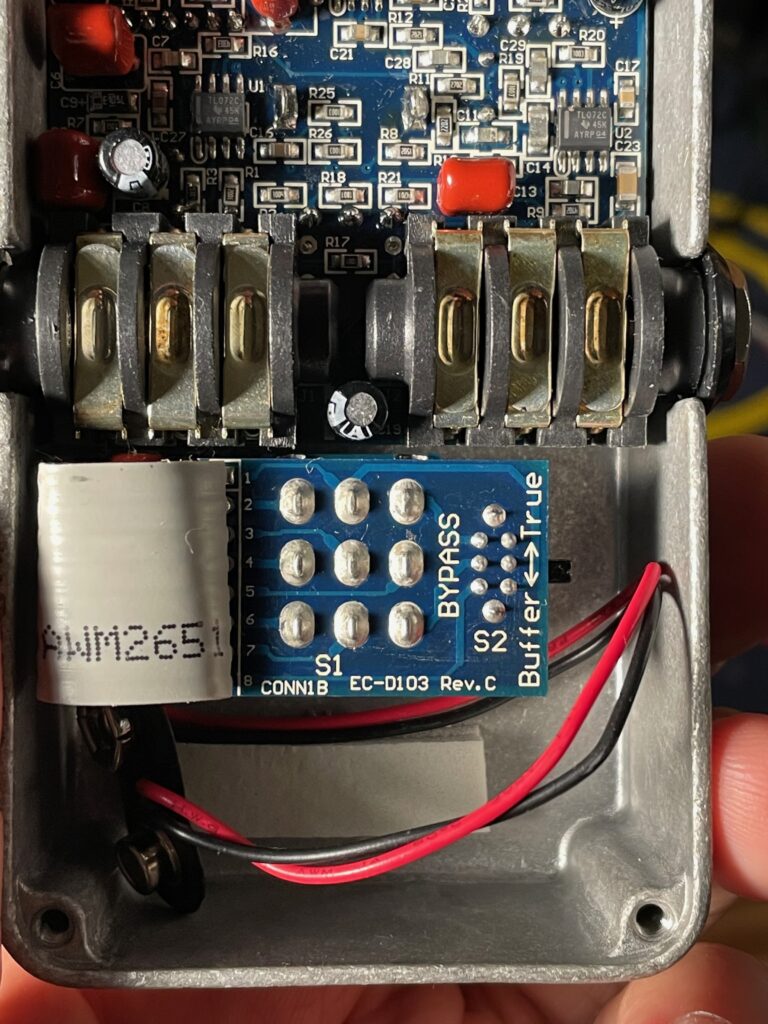
The Axe-FX 3 is running my own custom ‘OD Pedals v4’ preset. I’ve built this to emulate the sound and feel of my physical Marshall DSL20HR’s clean channel into a pair of 1×12 cabs fitted with Celestion A-Type and Celestion Blue speakers.
I’m not doing any post-processing in my DAW at all.
Can You Use The EHX Soul Food As A Clean Boost?
Regular readers will know that I use my Klon KTR in the classic clean boost configuration:
- Treble around 1 o’clock
- Gain around 8 o’clock
- Volume adjusted to roughly unity
I’m not looking to boost other pedals or my amp; I’m using the Klon KTR to shape the tone. This is the first test I do with any klone pedal, and so far only one klone I’ve tried has done this well: the Ceriatone Centura.
Into The Wampler Tweed 57 Overdrive Pedal
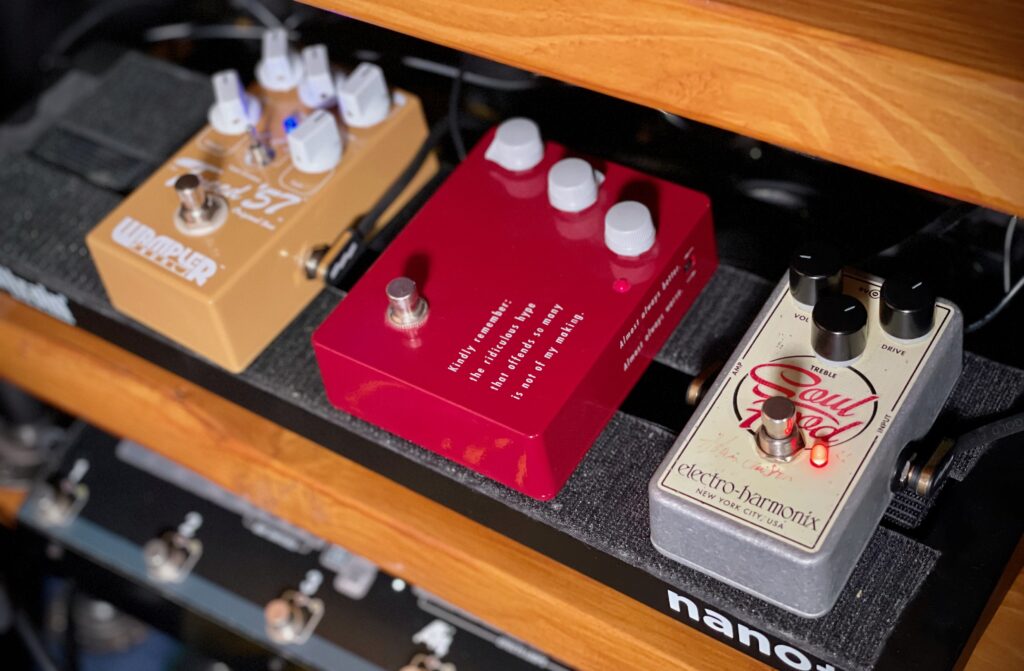
Granted, most people shopping for a Soul Food aren’t going to be running it into a rare, long-discontinued pedal like the Wampler Tweed 57. But there is method to my madness here, I promise!
I’ve picked the Wampler Tweed 57 because it’s one of those pedals where it’s very easy to hear what a Klon or a klone does to the tone. I’m not chasing the best possible tone here: I want to hear how similar or different the Soul Food and Klon KTR sound.
To start, here’s my Telecaster into just the Wampler 57. I’m on the guitar’s bridge pickup. Volume and tone controls are on max:
I’d describe that tone as brittle and boomy. The top-end and mids are nice, but it feels like there isn’t much room to tweak them without them falling apart (that’s the brittle bit). I’m hearing a solid low-end that sits nicely under the notes until I move down to playing on the low-E string. It becomes a little too prominent then (that’s the boomy part).
If I leave the Wampler 57’s settings in exactly the same place and switch over to my Les Paul, I think it becomes more obvious. I’m on the guitar’s bridge pickup. Volume is on 9, and tone is on max.
Do you hear how the overdrive has started to fuzz out? I suspect that the Wampler 57 isn’t really designed for the hotter signal from the humbucker. Even though this is a bright guitar (for a Les Paul), I’ve lost some clarity, and the low-end is just dominating every single note.
Those are my starting points. As I work through the audio demos, do come back and listen to those two again, to refresh your memory.
Let’s throw on the Klon KTR in front of the Wampler 57, and hear what it does. This is with my Telecaster’s bridge pickup:
I’m hearing a little more clarity. The KTR’s mid-boost effect has lifted the notes up over that low-end. The low-end is still there, and if anything, I’d say it’s more noticeable than before.
Now, let’s stick with the Telecaster, and throw the Soul Food on instead of the KTR:
How do the two compare to you?
Going back and forth between the KTR and the Soul Food, I can hear some differences. The take using the Soul Food sounds brighter to me, but paradoxically the pick attack isn’t as prominent as it was on the take that uses the KTR.
My guess is that the Soul Food is boosting the mids at a higher frequency than the KTR does, but I don’t have as much treble boost dialled in on the Soul Food.
I’m going to switch back to my Les Paul now. None of the settings have changed on any of the pedals. Here’s my Les Paul’s bridge pickup into the KTR into the Wampler 57:
I think the KTR has added a nice texture to the fuzzing-out overdrive. Has it added definition to the note attack, perhaps? I’m hearing less smearing of the sound, for lack of a better description.
Switching the KTR for the Soul Food, here’s what I get:
To my ears, this really demonstrates the points I was making earlier. Once again, the Soul Food sounds brighter to me, while not bringing out the pick attack. I say brighter; I think this has crossed over into being a bit harsh for me.
The other thing that’s coming across to me in this demo is the bass response.
The Klon KTR does cut bass a bit when it’s used as a clean boost. Most klones get this bit wrong, and end up cutting too much bass when the drive control is down low.
To my ears, the Soul Food goes the other way: I don’t think it’s cutting as much bass as my KTR does. That’s what I’m hearing on these demos with the Les Paul. With the Soul Food on, the bass is really thick and boomy, and just generally getting in the way of the notes.
Into The Wampler Belle / Claymore Overdrive Pedal
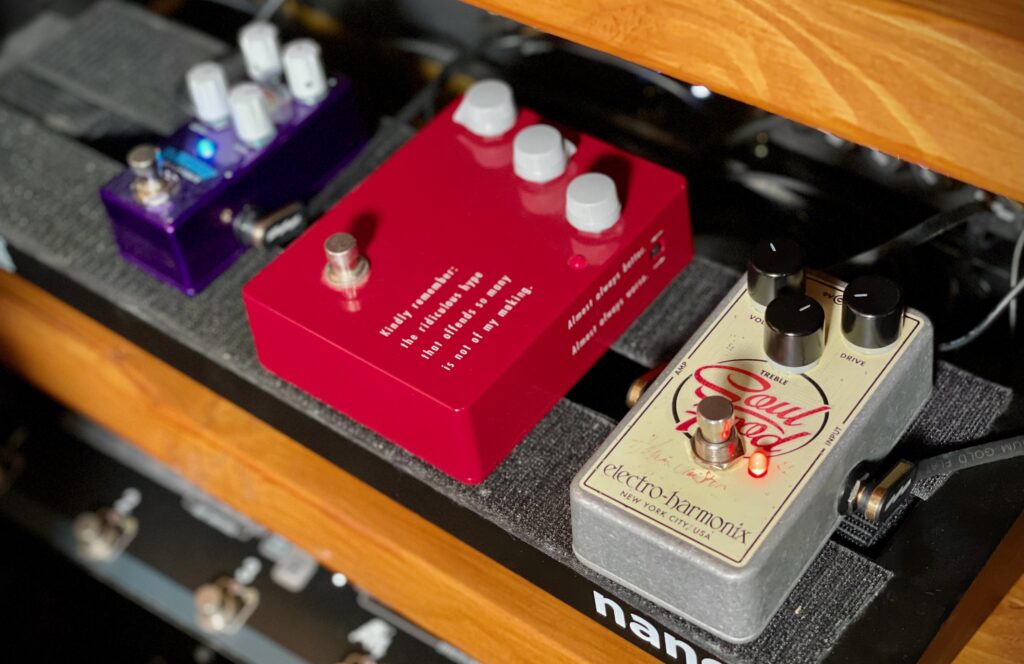
My next choice of pedal is a little more realistic, perhaps: Wampler’s Belle. This is Brian’s take on the Nobels ODR-1 overdrive pedal. The ODR-1 is an affordable overdrive that’s been used on countless hit records over the decades.
When I asked on GuitarTwitter how to show the Soul Food in a good light, one of the suggestions that came back was to run it into an ODR-1. As I don’t have an ODR-1, I’m using the Wampler Belle instead. Mine has the Claymore finish (in memory of Alex); it sounds identical to the regular green Wampler Belle that you can buy today.
This time, I’m starting with a sound that I already like. Here’s how my Telecaster sounds, straight into the Wampler Belle:
Does that really need any help from a Klon? Arguably not. I could happily spend the whole day just reeling off riffs with the Belle on its own. It’s got that song-on-the-radio sound.
What does the Klon KTR bring to that sound?
This time, I’ve rolled back the tone control my Telecaster just a little bit. I wanted that extra mid-range push and saturation that the KTR has brought, but I felt that the Belle was already bright enough.
Hand on heart, I can’t say that the Belle sounds better when boosted by the KTR. This is definitely a matter of taste. Here, I’m not trying to ‘fix’ a problematic sound. I’m using the KTR to change the flavour; to make a good sound into a great one. I’m not convinced it does.
Speaking of flavours, let’s hear how the Soul Food spices up the Belle:
I’m going to pick the KTR over the Soul Food ten times out of ten, based on how that sounded. To my ears, the KTR brings more life and energy to the tone. The Soul Food has left in too much bass, and just sounds a little dull – even though the tone control on the Soul Food is definitely above unity.
Again, I think this a matter of taste rather than objective points. You may well prefer the more rounded tone of the Soul Food.
Compared To The Wampler Tumnus Mini
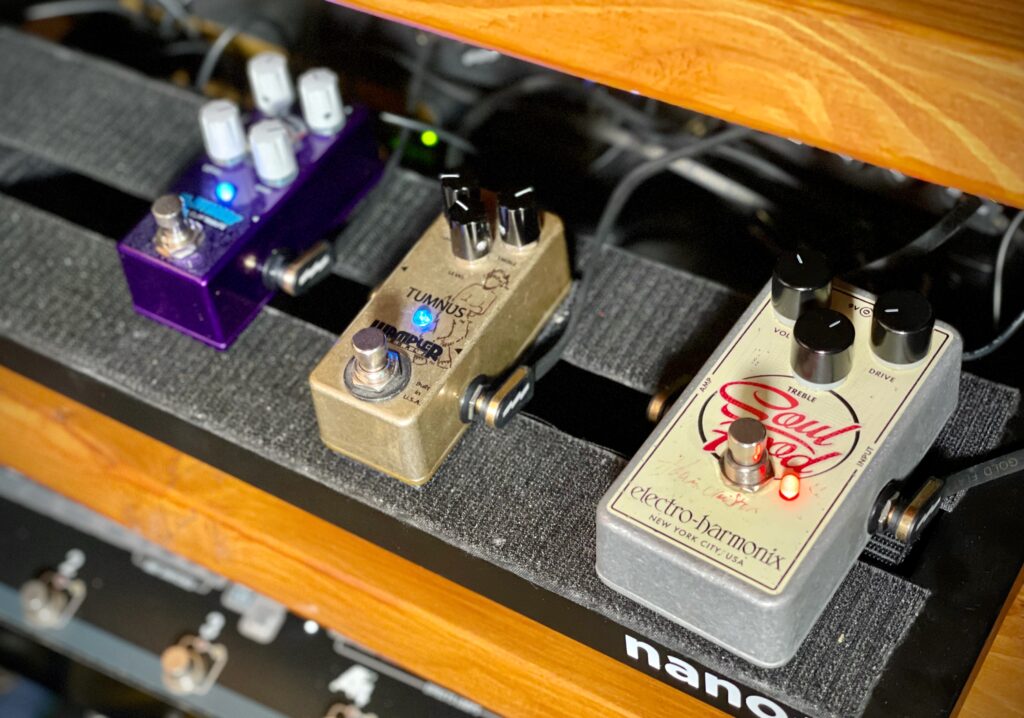
Over on GuitarTwitter, I was asked if I could compare the Soul Food to the Mosky Golden Horse. Now, I don’t have the Golden Horse, but I do have the pedal that it’s believed to be based on: the Wampler Tumnus Mini.
I’ve taken the KTR off the board, and put the Tumnus Mini on there instead. I’m still using the Wampler Belle, and I haven’t changed the settings from last time.
As a refresher, here’s how my Telecaster’s bridge pickup sounds straight into the Wampler Belle:
And here’s how my Telecaster’s bridge pickup sounds into the Soul Food into the Wampler Belle:
Got those two tones fixed in your mind? Then here’s the same Telecaster bridge pickup, but this time into the Wampler Tumnus Mini and then into the Belle:
Oh man. That sounds like rock and roll, right there. I think that’s a really good combination: Telecaster, Wampler Tumnus Mini, Wampler Belle. Can’t say that’s a surprise: you’ll find Brian playing a Telecaster on many of his own YouTube videos.
The thing that strikes me is that the Tumnus Mini makes the Belle sound full, without it sounding dull or harsh. Here, I think it does better job than either the KTR or the Soul Food. Arguably, it would sound even better if I dialled back the gain on the Belle a little bit, but I didn’t want to change the Belle’s settings from demo to demo.
Now, it’s not all roses. If I grab a different Telecaster – one with a humbucker in the neck – and play in the middle position, the Tumnus Mini’s main weakness comes through: like the Soul Food, it’s quite a bassy pedal.
(WARNING: what you’re about to hear is not a nice sound!)
As you can hopefully hear, the Tumnus Mini is really tuned for Telecaster bridge pickups. I’m assuming the Mosky Golden Horse will be similar. That’s why I’d always recommend looking at its big brother, the Wampler Tumnus Deluxe, if you’re not using a Telecaster on the bridge pickup.
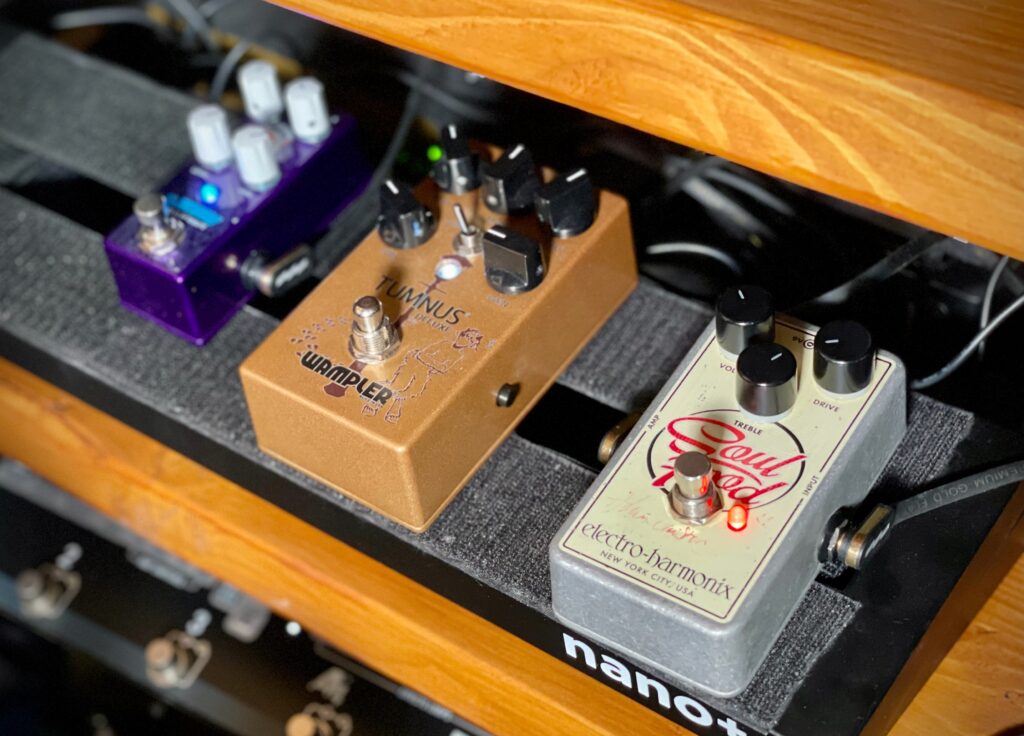
The Wampler Tumnus Deluxe gives me that unique 3-band EQ, allowing me to really shape the tone to suit both the guitar and the following overdrive pedal. Of all the klones I’ve tried over the years, it’s the most adaptable.
To Answer The Question
The question was: can the EHX Soul Food be used in the classic Klon clean boost role?
My answer is: yes, but. Yes, it can do the clean boost thing (something I can’t say for every klone), but I’d always choose something else if I could. For me, it’s the clean boost klone of last resort.
I’ve been pleasantly surprised at just how usable it is. It certainly isn’t the piece of garbage that I was expecting it to be. At the end of the day, though, it doesn’t quite sound like a Klon. That’s both good and bad. It gives me an option that I didn’t have before (which I like).
At this early stage (I’ve only had the pedal 3 days at the time of writing), I’m just not sure when the Soul Food is the right option for me.
Recommendations
If you’ve skipped to this part, go back and listen to the audio demos first, please.
- If you preferred the sound of my Klon KTR, but you can’t get a Klon KTR, look at the Ceriatone Centura. The one I’ve got sounds identical to my Klon KTR.
- If you’re looking for a klone to use with your Telecaster’s bridge pickup, look at the Wampler Tumnus Mini. I prefer it over my Klon KTR when I’m playing my Telecaster.
- If you’re looking for a klone and you’re more a middle-position player, then look at the Wampler Tumnus Deluxe. That 3-band EQ is makes all the difference, it really does.
The Soul Food’s main advantage is cost. Brand new, it’s about half the price of a Tumnus Mini, and a lot less than half the price of a Tumnus Deluxe or a Centura. If you like it, and can’t afford any of the others, then get it.
The Mosky Golden Horse is even cheaper, but I can’t recommend it because I’ve never played one. I do have other pedals from Mosky, and I’ve been very impressed with them. If you preferred the Tumnus Mini but it’s well out of your price range, give the Golden Horse a try.
We’re Not Done Yet!
I did say this was going to be a long one today.
There’s more to the Soul Food that a near-miss Klon klone. It can also be used as a standalone overdrive pedal. And, I have to say, I think that’s why I’m going to be keeping my example, rather than flipping it.
As A Standalone Overdrive Pedal
The EHX Soul Food …
I’ve changed the settings on the Soul Food to use it as an overdrive pedal. Tone and gain are both somewhere between 1 and 2 o’clock, and the volume control is around 9 o’clock.
This is what it sounds like with my Telecaster’s bridge pickup:
I really like what I’m hearing. It’s a little thin, perhaps, but it’s got that vintage vibe going on – all the energy is in the upper mids. With my Telecaster, there’s enough note attack for the notes to separate nicely.
Right out the box (if it had come with one 😂), I think that’s a very usable sound if you’re after an old-school vintage drive tone.
And I think it works even better with my Les Paul in the middle position (which is where I like to live):
I’ve spent quite a bit of time with that setup – Les Paul into the Soul Food as an overdrive – since the pedal arrived a couple of days ago. I’ve really enjoyed noodling with that, and there’s definitely been no complaints about the tone from Kristi either.
Perhaps the attack sounds a little too rounded, but I can always tackle that by adjusting the controls on my Les Paul. [I come back to that at the end of the blog post – Ed]
I think that demonstrates that the EHX Soul Food is definitely an option if you’re looking for a vintage-voiced overdrive pedal. Now let’s look at its main competition in this price bracket.
… vs The Boss OD-3 …
If you’re looking at the Soul Food purely as an overdrive pedal, then I think you’re also going to be looking at the Boss OD-3.
Brand new, the Boss OD-3 is £10-20 more than the EHX Soul Food. However, there’s always plenty of second-hand OD-3s available to buy. That puts both pedals pretty much in the same price category.
I’ve taken the Wampler Belle of my board, and put the Boss OD-3 on there instead. Both the level and drive controls are set somewhere around 10:30, and the tone control is a little past 12 o’clock.
Here’s how it sounds, with the bridge pickup of my Telecaster:
To my ears, both overdrives have similar characteristics, but they clearly have important differences too. The OD-3 has a bit more bite, a lot more body, and the mids are not as prominent. I think it also has a bit more saturation than the Soul Food does.
I think that’s really obvious when I listen back to the OD-3 and my Les Paul in the middle position:
I don’t have anything to add to that. I think the audio speaks for itself. It’s a very nice sound to play through here at home.
I’m not quite done yet, though. There’s one more pedal that I want to compare the Soul Food against today.
… vs The Boss BD-2 Blues Driver
Boss’ venerable Blues Driver is another very popular drive pedal in the same price bracket as the Soul Food. Arguably, it’s more famous than the OD-3 that I’ve just compared against.
Brand new, the Boss BD-2 can be had for around the same price as a brand new EHX Soul Food. There’s always plenty of second-hand BD-2s to be had as well, although it can be very difficult to find one for a bargain price.
Here’s how my Telecaster’s bridge pickup sounds into the Boss BD-2:
The first thing that leaps out at me is just how much attack there is in each note compared to the Soul Food. The BD-2 is far more aggressive. That makes sense, as the BD-2 is more of a distortion pedal than an overdrive.
For me, the Soul Food has a more vintage sound, with all of its energy in those upper mids. With the BD-2, I’m hearing higher highs and lower lows. I don’t think it’s as focused as the Soul Food is. It sounds much more modern, if you like.
I’m not a regular BD-2 user. My instinct is that the BD-2 is voiced more for neck or middle pickup position than for bridge pickups. I found those extended highs to be a little tricky to dial out with a bridge pickup.
To finish, here’s how the BD-2 sounds with the middle position of my Les Paul:
This is a tricky one for me. On the one hand, the note attack is a little too rounded off with the Soul Food, while the BD-2’s note attack isn’t rounded off enough.
Let me go back to the Soul Food with my Les Paul, and see if I can tweak the pedal to get a bit more attack in those notes:
Well, that’s interesting. By turning up the tone control, I’ve made the Soul Food louder than before. I’m looking at the waveforms in my DAW, and the difference in volume really stands out.
I have plenty of note attack now, but I’m finding it to be a little harsh on its own. Maybe it’s perfect for a mix, I’ve no idea 🤷♂️ Hopefully, I can tame that a bit by rolling back the bridge tone control on my Les Paul:
I may have overdone that slightly!
I think I would have been better off nudging back the tone control on the Soul Food first, and then using my Les Paul’s tone control just to take the very top off the treble.
Answering The Question
The question was: can we use the EHX Soul Food as a straight-up overdrive pedal into a clean amp?
My answer is: yes, and if you need a vintage tone, it’s got to be on your list of pedals to audition. My personal tastes lean more towards an outright tweed-tone pedal, but it’s exactly that: a personal taste.
I think the tricky bit is getting the note attack shape right for what you’re doing. The tone control on the Soul Food … it’s not subtle, and very small moves make a big difference. If I was using it, I’d put a lot of time into finding the exact spot that suited my amp and guitar.
Recommendations
The Soul Food held up very well against two classic Boss pedals, didn’t it?
If you’re after a standalone overdrive into a clean amp, I think it’s a straight competition between the Boss OD-3 and the EHX Soul Food. It comes down to what vibe you’re after.
- If you want or need a vintage tone, I recommend starting with the Soul Food every time.
- If the Soul Food sounds too vintage to you, then I recommend going with the Boss OD-3.
Until I learn how to dial in a sound that I like, I can’t recommend the Blues Driver as the only source of your dirt.
Final Thoughts
If you’re still with me after this marathon of a blog post, thank you very much 🙂
It would have been very easy for me to dash off a quick First Impressions post using the absolutely awful tone I had when I first put the Soul Food on my board. Don’t think that I wasn’t tempted! I came into this with the impression that the Soul Food was hot garbage, and that first evening with the pedal only strengthened that feeling.
I would have missed out if I had stopped right there.
Do I think the Soul Food is a good Klon klone? No, I don’t. While it’s usable, I haven’t (yet!) found a reason to choose the Soul Food on tone alone. The mid-boost just isn’t that sweet-sounding, and it doesn’t affect the next pedal in the chain quite how I’m used to.
One thing I found interesting: when I was working with each pedal, and going back and forth all the time, the differences seemed very stark to me. Listening to the demos back to back to back, the Soul Food isn’t as far off the other pedals as I thought at the time.
Since I got the Soul Food, I’ve spent most of time exploring it as a straight-up overdrive pedal into a clean amp. I’ve had a lot of pleasure out of that, and I think the Soul Food has a real future as a character drive. It gives me a very usable new option, and that always makes me happy.
I’m curious now about the JHS-modded Soul Food. I wonder how that compares. I’ll have to see if I can pick one up at some point to find out.

One Reply to “#CoffeeAndKlon 33: The EHX Soul Food”